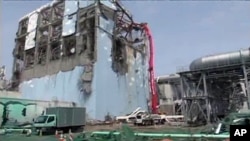A team of United Nations nuclear specialists from 12 countries has begun a week-long investigation in Tokyo into the crisis at the Fukushima Daiichi nuclear power station. The team will compile a report on the world's second worst nuclear accident to be presented at a meeting of the International Atomic Energy Authority in Vienna in June.
The team began their work Wednesday at Japan's nuclear safety agency, where they were briefed on a lengthy report submitted to the agency by Tokyo Electric, which operates Fukushima Daiichi.
Mike Weightman, the British government's nuclear safety head and leader of investigation, outlined what he hopes to discover. "Our focus is to gather information, and use that information to seek to learn lessons so the world can improve nuclear safety," he said.
Weightman and his team already have volumes of information to comb through.
In recent days Tokyo Electric has made public hundreds of pages of data and logs from Fukushima Daiichi and revealed more about what it thinks happened after the March 11 earthquake and tsunami.
All three reactors that were running as the quake stuck are thought to have suffered nuclear fuel meltdowns within days.
A meltdown is one of the nightmares of nuclear power and happens when cooling water at the center of the reactor falls, exposing fuel rods to the air. The rods then heat up and can eventually melt.
It is difficult for Tokyo Electric to know exactly what happened because it is impossible to look inside the reactors. But engineers believe most of the melted fuel has collected at the bottom of the pressure vessels at the reactor core.
Engineers have focused attention on these pressure vessels because they are suspected to have sustained damage during the meltdown, possibly creating holes. This may have allowed some melted fuel and highly radioactive water to leak into the secondary containment vessel.
If a leak occurred, the accident is more severe than originally thought. But engineers say it should not mean an immediate change in Tokyo Electric's plan to get the reactors under control by January 2012.
The IAEA team is due to travel to the Fukushima Daini nuclear plant on Thursday and visit the Daiichi plant on Friday morning.
Their report will be made public during a ministerial conference on nuclear safety at IAEA headquarters in Vienna from June 20 to 24th.
UN Team Begins Investigation into Fukushima Crisis










